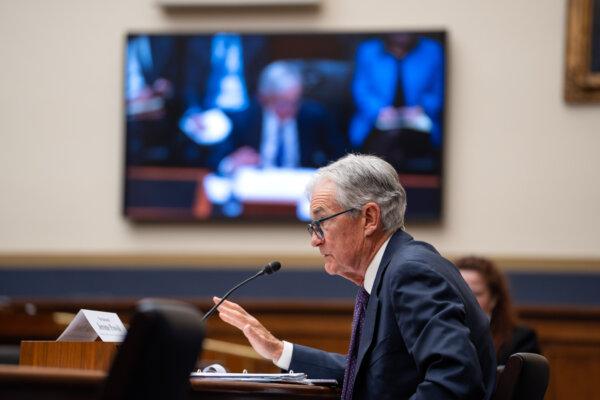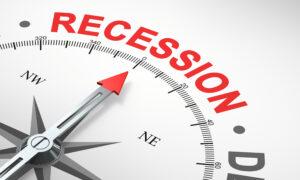The Nasdaq slips into correction territory.
Wall Street navigated a fresh round of turbulence to kick off the trading week after President Donald Trump did not rule out a tariff-driven recession.
As of 12:12 p.m. ET on March 10, the blue-chip Dow Jones Industrial Average was down 495 points, or 1.16 percent.
The tech-heavy Nasdaq Composite Index plunged more than 620 points, or 3.41 percent, officially transitioning into correction territory (down 10 percent from its high). The broader S&P 500 erased more than 124 points, or about 2.17 percent.
Treasury yields were also red across the board as traders sought shelter amid the volatility. The benchmark 10-year declined to around 4.22 percent. The two-year yield slipped below 4 percent, while the 30-year yield struggled to hold 4.53 percent.
Economic fears have traversed the financial markets as investors worry that a global trade dispute will ignite a downturn. These concerns were exacerbated after Trump declined to rule out the possibility of a recession.
“There is a period of transition because what we’re doing is very big,“ he said. ”We’re bringing wealth back to America. That’s a big thing. And there are always periods of … it takes a little time, it takes a little time.”
The president described his tariff plans as protecting the American people after being “ripped off for many decades.”
“We’re not going to be ripped off anymore on the tariffs,” he said.
Later, when reporters aboard Air Force One asked for further clarification, Trump said, “Who knows?”
Trump recently imposed 25 percent tariffs on Canada and Mexico and doubled levies on China. Days later, he extended a one-month pause on all products from Canada and Mexico covered by the United States–Mexico–Canada (USMCA) free trade deal.
In a March 6 Truth Social post, Trump said he agreed to this pause “as an accommodation” for Mexican President Claudia Sheinbaum.
The administration is also poised to implement reciprocal tariffs on all U.S. trading partners next month.
“There’s going to be no recession in America,” Lutnick said. “Global tariffs are going to come down because President Trump has said: ‘You want to charge us 100 percent? We’re going to charge you 100 percent.
“So if Donald Trump is bringing growth to America, I would never bet on recession, no chance.”
Recession Talk Returns
Heading into March, a widely watched economic indicator started flashing red.
As the first-quarter growth estimate garnered widespread attention, economists at the regional central bank sought to clarify what the tracker was suggesting.

Federal Reserve Chairman Jerome Powell testifies before the House Committee on Monetary Policy in Washington on Feb. 12, 2025. Madalina Vasiliu/The Epoch Times
Patrick Higgins, policy adviser and economist at the Atlanta Fed, determined that gold imports significantly drove the downward revision.
“Removing gold from imports and exports leads to an increase in both GDPNow’s topline growth forecast and the contribution of net exports to that forecast, of about 2%.”
Federal Reserve Chair Jerome Powell sought to ease growing market fears, telling an audience last week that the U.S. economy remains “in a good place.” However, he noted that the outlook could evolve as business and household sentiment weakens.
The key consumer sentiment and confidence indexes, including The Conference Board and the University of Michigan, have tanked over the last two months.
Other market watchers have shrugged off recession worries.
Torsten Slok, chief economist at Apollo Wealth Management, believes the United States might witness “a modest stagflation” rather than a recession.
“DOGE [Department of Government Efficiency] and tariffs combined are a mild, temporary shock to the economy that will put modest upward pressure on inflation and modest downward pressure on GDP,” Slok said in a note emailed to The Epoch Times.
Stagflation, reminiscent of the 1970s, is an economic environment comprised of anemic growth, high inflation, and rising unemployment.
“Investors must now navigate the possibility of stagflation—a combination of slow growth and rising prices that hasn’t seriously threatened markets in decades,” Joe Tigay, portfolio manager at the Catalyst Nasdaq-100 Hedged Equity Fund, said in an emailed note to The Epoch Times.
But while there is panic on the streets, investors need to keep calm, says Nancy Tengler, the CEO and chief investment officer of Laffer Tengler Investments.
“It’s always excruciating when you’re in the middle of a correction, and I think that’s where we are,” Tengler said in a note emailed to The Epoch Times.
“The important thing to stress here is that we get a correction once every 12 months, and it’s always spurred by something.”
Original News Source Link – Epoch Times
Running For Office? Conservative Campaign Consulting – Election Day Strategies!


